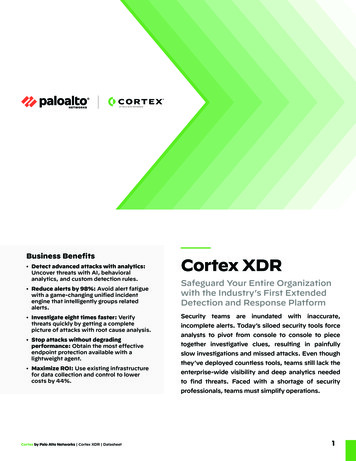
Transcription
eBOOKXDR: The Secret to HighlyEffective Managed Detectionand Response (MDR) Services1
Table of ContentsI. Introduction: Today’s Cyber Threat Landscape Demands Rapid Response3II. What Is Extended Detection and Response (XDR)?5III. How It Works: A Deep Dive into XDR7IV. A Peek Under the Hood: How Machine Learning Enables Highly Effective MDR8V. Better Together: MDR XDR9VI. What to Look for in an MDR Provider11VII. Not All MDR Is Created Equal: What Sets eSentire Apart12VIII. Conclusion14www.esentire.com
I. Introduction: Today’s Cyber Threat Landscape Demands Rapid ResponseThe job of a cybersecurity professional has never been easy, but the events of the past two years have tested the defenders’resolve in new ways. With easier access to ever-more sophisticated tools, attackers have launched an escalating wave ofattacks based on familiar threat actions.Cyber bythe Numbers 4.24Maverage cost ofa data breach 847Kaverage paymentdemanded by cybercriminals in 202051%security professionals reportingtheir team’s performancewas negatively impacted byremote work3.1MPhishing attacks, the exploitation of stolen credentials and social engineeringare continuing to result in large-scale data breaches,1 with the average breachnow costing its victim 4.24 million — the largest single-year data breach costincrease in nearly a decade.2 Meanwhile, ransomware attack volumes reached anall-time high, with the average payment demand also skyrocketing to a historicalpeak of 847,344 in 2020.3With costs and risks on the rise, security teams are being stretched thinner thanever. The shift to work-from-home wasn’t easy for many security operationsteams to navigate, with 51% of security professionals reporting that theirteam’s performance was negatively impacted by remote work in a recent surveyconducted by FireEye.4 In that same survey, more than 80% of security analystsdescribed their jobs as “painful” or “very painful” due to workload increases thatare driving them to the brink of burnout.5Despite these challenges, rapid response capabilities are essential. Databreaches that take more than 200 days to identify and contain cost an average of 1.26noil m reom hat nhot es hat reat entdi 4edi nda fulnto cyl nedia ni esl hats n6200 days. Organiationsz thatwantomitgaet thisigni4cant4nancialriskmustbe able to contain malicious activities within their environment in far less time,and do so consistently.To achieve this end, it’s essential to maintain threat detection, investigationand response capabilities that are highly effective, and that are in place 24/7.Growing numbers of organizations are looking to Managed Detection andesR rvit esc ohelt pthem meet this need. Only 54% of organizations currently have access totheir own Security Operations Center (SOC) – and a mere 44% of those withfewer than 10,000 employees do.7 This is the case despite the fact that SOCcapabilities are the key to building a mature cybersecurity program. Manycompanies are outsourcing these activities so that they can gain access toexpertise and reduce risks without having to turn their focus away from theircore business competencies.un4lledpositnsforskiledcybersecurity professionalsglobally in ts/2021-data-breach-investigations-report.pdf, reat-report, 4https://www. 021.pdf,https://www. , 7451 Research. Voice of the Enterprise: Information, Security,8Organizational Dynamics 2020.133www.esentire.com
Organizations with Access to an In-House SOC54%44%organizations have access toan in-house SOCorganizations with fewer than 10,000employees have access to an in-house SOCAs a result, the market for Managed Security Services (MSS) is fast-growing and competitive. Gartner reports that there’sbeen 44% growth in prospective buyers’ inquiries over the past year.8 But with more than a thousand companies aroundtheglobenowo3eringsomeformofsmore,it MS di6culthanevero4guretoutwhaestmak aserviec o3eringhighlye3ective.Theresnostandardediz arentquantitavemeasuresthat can be applied universally to evaluate performance.In fact, every MDR provider faces the same array of challenges that an in-house security operations (SecOps) programdoes.Skiledcybersecuriyprot fessionalsremaininshortsup,wiply thanesedtima 3.1milonun4lledpositnsaround9the globe in 2020. Andthequayoflit anMDRprovidersserviesc isdependentuponthee3ectivenessofitspeople—the security analysts, threat hunters, incident responders and content and automation engineers that do the detective,investigative and operational work of containing atscleacrosmultipleclientsenvironment.This essmak itabsolutelycritical that SecOps teams are supported and enabled in their work. To furnish the top-notch support that makes highlye3ectiveMDRserviec posible,aprovidermustinvestintherightect venessandesmak iteasiero4ndt andremedeiat threatsapeed.XDR is this technology foundation. In the remainder of this report, we’ll explore what XDR is, how it works and why itenables security professionals to do the best possible work.451 Research. Voice of the Enterprise: Information, Security, Organizational Dynamics 2020. 8https://www.gartner.com/doc/reprints?id 1-27JN2ORS&ct 210928&st sb,9 hx?la en&hash tire.com
II. What Is Extended Detection and Response (XDR)?Evenbeforetheeventsof2020,manyorganiationsz struggledomaintt aine3ectivesecuriyoperat tionsprogra.msWith growing numbers of workloads moving to the cloud, IT ecosystems were becoming increasingly complex anddistributed. At the same time, widespread adoption of DevOps practices led software release cycles to become shorterand shorter. In conjunction with the cloud’s ephemerality, this meant that organizational computing environments wereincreasingly dynamic and ever-changing.Not only had attack surfaces grown, but business-critical operations had become increasingly reliant upon digitaltechnologies, making the potential consequences of an incident or breach more serious. With the expansion of the attacksurface came a corresponding increase in the number of logs and telemetry sources from the environment that SecOpsteams were tasked with monitoring.Today, digital business processes are more critical to the bottom line than ever, while sweeping adoption of hybridand work-from-home policies is further expanding the attack surface. In the face of this constellation of challenges, legacysecurity architectures built from an expansive array of point solutions operating in siloed fashion can no longer keep up.ecS urinfoI y t rmnoita nda EventnaaM gement(SEMI )fotalp rmendts eb o t ne6cienti unklc & nda y werentesd gnedirop o t viedanalysts with highly relevant background or the contextual information needed to make good decisions in real time.The Limitations of SIEM in the Modern Threat LandscapeSIEM technology evolved largely in order to meet compliance requirements, which mandated thatorganizations store and retain log data in a single, centralized location. The technology’s usefulness forthreat hunting or post-incident investigations quickly became apparent, but SIEM was never designed —or intended — to serve as a correlation engine in real time. Making it possible to answer complex questionsacross correlated data was never among SIEM’s strengths, and platforms typically require extensivetuning, rules-writing or programming before they can be used to help real-world analysts understandwhat’s going on in the environment.XDR was developed to solve these problems.Thoughmultiplede4nitionsoftheermt exist,wefavortheoneadvancedy451besR earch.Acordc ingothisde4nition,extended detection and response is a technology approach that involves combining a pre-built integration of multiplesecurity telemetry sources with analytics and response capabilities.10In many security programs, SIEM solutions were brought in to house event logs from a broad array of security tools,operating systems, applications and network appliances. SIEM enabled analysts to correlate and search this log data, butoften didn’t provide analysts with adequate real-time visibility into activities taking place on endpoints, where a majorityof threat actors make their initial foray into the environment. Hence, SecOps programs began adopting purpose-buildendpoint detection and response (EDR) tools. EDR gave them the ability to gather data directly from endpoint devices tosupport threat detection and investigation, as well as to execute certain response actions. EDR’s limitation, however, lusivelothey endpoint.451 Research. Technology & Business Insight: The Rise of Extended Detection and Response105www.esentire.com
XDR provides next generation detection and response capabilities, extending the enhanced visibility and threatontc ainmentfunctionaythali tNDRandEDRo3eracrostheentiretyoftheITecemstyo .XDRbringsontc exto texternal threat intelligence and to the internal business environment by synthesizing data from synthesizing securitytelemetry including network, endpoint, cloud, email, identity, the Internet of Things (IoT) and more.Born of the need for complete attack surface visibility in today’s distributed and heterogeneous computing ecosystems,XDR4ndernstspawithinthedatingesedt oaidthreatdetection,reducefalsepositvesandauteomat threatresponse&remediaton.Thiessmak ngiecs urieaty htiW. sm hetbest approaches to XDR, there’s enough contextual information from the customer’s environment – and adequateunderstanding–obteableontct ainthreaton4dsc ent.Thily ontsc ainmentcanbeautedomat ,knowingthatheprocess won’t interrupt critical business operations unnecessarily.Business Leaders Must Drive Security Efficiency94%80%of workloads are forecastedto be running in the cloudby the end of 2021.11of organizations will continue toallow users to work from homeafter the pandemic’s end.1284%87%DevOps teams arereleasing new features fasterthan ever before.13of organizations reportnot having enoughcybersecurity t-report/white-paper-c11-741490.html, tha-dt e4ne-the-new-emer-emyploee-relyploationshi, x u5RjB ,14451 Research. Technology & BusinessInsight: The Rise of Extended Detection and Response.116www.esentire.com
III. How It Works: A Deep Dive into XDRThoughwevedescribedXDRastheect derso4ndt andremediate threats at speed, XDR is more than just a single technology. Instead, it’s an approach that strives to integratesecurity tools, control points, telemetries and analytics into a comprehensive enterprise-wide system to cut throughthe noise and enable analysts to focus on the security events that most warrant attention.XDR gathers signals from across the whole of today’s cloud-native and hybrid architectures. It normalizes, enriches andontc extuaesliz thisdat,initiangautedomat responsesinsecondsforhigh4delysecit uriydett ectionswerfulo .Pmachinelearning (ML) models are applied to XDR platforms to provide human experts with the right information at the right time.SOC analysts and threat hunters are empowered to hunt, contain and respond to attacks exponentially faster - with lessfatigue and frustration, when an automated response is not possible. XDR also delivers reliable insights to accelerateinvestigation analysis and streamline risk reporting.SIGNALSe S E N T I R E T H R E AT R E S P O N S E U N I T ( T R U )Proactive hunting and researchNetworkEndpointLogCloudInsiderDevelops detection modelsIntelligence and analyticsAT L A S X D R C L O U D P L AT F O R MCloud-Native PlatformAutomated Disruptions24/7 SOCeSentire experts hunt, containand respond to attackers20.5M6000Daily SignalsIngested3MMachine Learning ModelsDaily ations40015minDaily Threat Mean TimeConatinments to ContainDaily Atlas XDRAutomated DisruptionsS E C O N D S T O R E S P O N D M I N U T E S T O C O N TA I NInsight PortalAccess investigation analysisand risk reportingVulnerabilityMulti-Signal IngesteSENTIRE SECURITY NETWORK EFFEC TSSecurity that scalesAmplifying detections across base400 indicators added dailyHere are some key facts about XDR’s core capabilities: XDR ingests multiple signal sources. What makes XDR powerful is that it’s able to gather and normalizedat from acros the enitre environment. This enables high-4delity detection because it gives security eamstrue and comprehensive visibility from endpoint to cloud and beyond. Ideally, there should be no limits on whatthe security team can see or how much information can be incorporated into analyses. This means includedtechnologies shouldn’t be limited to a single vendor’s product portfolio or solution suite. Intelligent analytics eliminate noise and greatly reduce false positive rates. In traditional SIEM-centricsecurity architectures, high false positive rates are a perennial problem, as well as the primary contributorto burnout among security analysts. Excessive noise can also lead to alert fatigue, which can ultimately resultin failures to detect if analysts end up dismissing alerts because they simply don’t have enough time toinvestigaet al event.s In XDR, machine learning (ML) models and arti4cial ntelligence (AI) algorithms aidanalysts in recognizing patterns. The technology does so by automatically bringing in contextual dataand taking investigative steps that a human would otherwise have to take. The end result is time savingsand far fewer false positives.7www.esentire.com
Enriched data and contextual information enables threat hunting. Because multiple di3erent typesof signals are ingested by the XDR platform, it’s possible to see relationships within this rich data when it’s theobject of human investigation in threat hunting. If there’s evidence of attack techniques that were used in thepast, of relationships between the various parts of an attack sequence, or of activity patterns that are clearlymalic ous, this becomes readily ap rentotsecurity researchers. When the models have high ocn4dence,automated response actions can be initiated. Automated response capabilities dramatically accelerate threat containment. When an XDR platformincorporates automated response capabilities, it’s possible to initiate containment activities in mere secondsif theres a high degree of ocn4dence that an observed activity is risky or malic ous. Aotp-performing XDRplatform that leverages proprietary decision-making technology to facilitate automated disruptions can executee3ective, safe and ap ropriaet ocntainment prootcls whenever theres clear evidence that heyre warranted,reducing threat actor dwell time. XDR platforms can learn from current threat intelligence, observed investigations and responseactions taken across the platform. Top-performing XDR platforms can make use of large volumes of data oncurrent and emerging threats to improve detection accuracy. In particular, an XDR platform that sees detections,investigations and response actions across a large number of customer environments will be able to learn fromthat information. It can generaliez from those learningsot he bene4t of al cusotmers. The investigation sept slearned in one customer’s environment can be automated in another’s, and response and containment activitiesthat were successful in one environment can be extended to all customers. It’s a rapid feedback cycle that’sconstantly improving and hardening the security postures of the provider’s global customer base. XDR supplies proactive security that scales. In traditional security architectures built around thecapabilities of a SIEM, each additional signal source that the security team adds has the potential to increasethe false positive rate and contribute to security analyst overload. Not so with XDR: increasing the numberof signals ingesedt actual y enhances detection 4del. Wihaty s tmore, because ingesting more dat leads otbeter-qt ualiyt nvestigations and responses, this i an e3ect has tampli4ed when more cusotmers leverage theplatform. This network e3ect is he reason that expanding the siez of an MDR providers global cusotmer shouldonly improve its capabilities.IV. A Peek Under the Hood: How Machine Learning EnablesHighly Effective MDRHow, exactly, can an XDR platform help security teams solve some of the most pressing and longstanding challengesthat have plagued SecOps since the dawn of the modern computing era? To answer this question, we’ll need to take acloser look at the advanced algorithms that lie at its heart.When security analysts are responsible for manually monitoring and triaging events, limited time and resources are theenemy. It’s not easy to pay the right amount of attention to each alert when you’re confronting hundreds of alerts dailyand facing an enormous volume of unstructured data to analyze. In fact, as many as 79% of alerts go uninvestigated insome security programs due to a lack of analyst time.15Machine learning (ML) excels at pattern recognition. Finding subtle patterns in large volumes of data isn’t a task that’s agood match for how humans think, but it’s where ML shines. The machine learning models that investigate events in elationshipswithinthedi3erentypest Pro158www.esentire.com
In many ways, ML models “think” according to a pattern that’s the exact opposite of how human cognition works. When itcomes to people’s attention, the more information and distractions there are, the harder it is to see and remember what’smost important. For ML, the converse is true: the more data there is in the training set, the more examples there are tolearn from. The more examples there are to learn from, the better the model can predict the solution for a new example.This is why data is like gold for AI-powered systems. And, in fact, data that’s annotated so that it can be used as a learningexample is the real gold. This is also why AI-powered systems are so well-suited to automate actions that tend to befatiguing and overwhelming for humans.XDR acts as a force multiplier for the human security analysts within a SOC environment because it draws theirattention to what matters most. The technology learns from previous investigations, so it’s able to suggest thebest actions to take in each novel investigation situation.The “Brains” of the SOC:How XDR Aids Detection, Investigationand Automated ResponseXDR Use Case:Threat Hunting for MaliciousPowerShell ActivityAn industry-leading XDR platform will automatehigh-cn4do encethrearest nsop esnda, whereucs haresponse isn’t possible, present the security analystssupporting it with a rich data object for investigation.This data object will be enriched with contextualnfoi rmnotia nda stripedfo vendr-so peci4cetd thalia tmight otherwise made it hard to understand.PowerShell has been part of Windowsfor over a decade. It’s popular amongIT administrators because it gives themextensive access to the operatingsystem’s internals. But it’s also widelyexploited by attackers.Threat hunters often focus on searchingfor PowerShell exploits because they’reso prevalent.The platform makes it easy to answer questions like these: Which of these pieces of information are relevant?However, examining every singlePowerShell script that runs in an enterpriseIT environment manually would consumean enormous amount of time and energy. Which of these events are related? W hich activities are obviously, clearly anddemonstrably malicious? W hen it is appropriate to initiate an automatedresnsop ework5ow?unniRnganMLmodelesmak ite3ortleso stmonitor all PowerShell executions. Each canbe automatically scored according to howlikely it is to be associated with maliciousactivity. Those that trigger alerts do so withahighdegreeofon4dc ence.Thereasonsuchahighdegreeofon4dc enceispobleisthatthe platform had access to a large number ofexamples of previous PowerShell executions– all labeled “benign” or “malicious” whenthey were investigated. What requires further analysis and human attention?Whenthererea veryhigh-cn4do encensa wersfo al tthese questions, investigation and response can be fullyuta edtamo Thi. ents reli remy veso humna e3ortfromthe process.In cases where there’s some ambiguity, the platformgives analysts ready access to the sort of in-depthinformation that makes their jobs easier. It also allowsthemebot reom reac tive,havereom n4doc encenitheire3ectivenesndas, reompst threaThits. yamsexplain why integrating security technologies is notonly associated with a 10.5% increase in a securityprograe3ecsmtivenesutbs, stroi nglrrelocy edta withimprovements in the recruitment and retention of talent.16This transforms threat hunting froma “needle in the haystack” search to ahypothesis-driven activity that has a highproyofbailt omes-study-main-report.pdf169www.esentire.com
V. Better Together: MDR XDRGiven the realities of today’s challenging threat landscape, it’s no surprise that growing numbers of business leadersarechoosinganaM gedDetectionandesR ponsevero traditonaanalM gedecS urierviySt esc .Aprimarybene4tofMDRis that it prioritizes rapid response, threat containment, and remediation actions, alongside the alerting and monitoringcapbiltesthaompritc sedthestandardMSo3ering.When a provider is fully invested in managing incidents all the way through to resolution, they have a strong incentiveto deliver superior overall security outcomes. They can’t act as a mere alert factory — delivering high volumes of falsepositives without an actionable response component to their services.Though the abbreviations are similar enough to confuse the uninitiated, MDR and XDR aren’t the same thing.MDRrehenspmo c a sivei ervis ec 3erio nghat uib s tupl no hit stechnology foundation, but it also includes access to humanexperts, taking intuitive, manual actions to respond & remediatethreats, and optimize security operations, when an automatedaction is not possible.XDR is a technological approach thatenableshigh-4delydetit ection,faerstand more accurate investigations andautomated responses.More than a tool: XDR is a technology, but it’s also a living artifactWhen cybersecurity vendors sell XDR solutions, they’re providing tools. These may be powerful and full-featured toolset,buts theyrestaic.WhatanMDRproviderinseat s tnecessaryotransformtheseolsintt entoapt enablerofe3ectivesecuriyoperat tionsandrapidthreaonttc s tingcontent, leveraging threat intelligence, learning from historical investigations — that few in-house security programshave ready access to.Consider, for example, detection engineering. This is a critical support function for security operations teams and XDRplatforms, but it’s one that we don’t often discuss. Detection engineering is what enables the XDR platform to performaccurate and comprehensive detection. Together with automation engineering, detection engineering provides thecontent that powers the platform. But it requires constant curation – by a team of experts – to stay ahead of dynamicattacker behaviors.Inaditon,securiynett worke3ectsarecrioXDRtical sucesc s:themorethreatdandinvestigation&responseactions that the ML models can be trained on, the more accurately they’ll detect, investigate and respond to maliciousactivity. Thus, an XDR platform that’s able to incorporate a large amount of investigation data from a diverse set of resucesc sfulande3ectivethanonewithesca ofewerstandless diverse investigations. An MDR provider’s collective history of investigations gives the platform a source of wisdomthat’s larger than the sum total of any individual enterprise’s cybersecurity threat and incident history.Anindustry-leadingmulti-signalMDRserviec providerwilo3erfarmorethanmereesca oXDRst ect hnologies,including:Capable and full-featured security monitoring coverage Correlated Alerting, triage capabilities, threatinvestigations & tactical threat containments24/7 expert-level SOC support emR ediatonrecomendations,actionsandveri4cationthat have been learned from and validated acrossa large number of customer environments Advanced detection engineering driving automatedthreat disruptionsElite, hypothesis-driven threat hunting10www.esentire.com
VI. What to Look for in an MDR ProviderIn today’s complex and ever-evolving threat landscape, speed is of the essence. A majority of attackers (54%) are ableto breach a target environment in under 15 hours,17 and most ransomware strains can spread across a victim’s networkinthreeofot stsecond.Thes mostvirulentcanachievethis18in less than 45 minutes.There are several factors that are critical to keep in mind as you evaluate MDR providers:Consider the Mean Time to ContainThe best strategy for mitigating risks and protecting your organization from the potential devastation that such attackscancauseoculist tivaet rapidresponsecapbiltes,4rso.S tandforemost,lkforanMDRproviderwilingoa mitcMean Time to Contain malicious activity. In addition, you should understand the length of time it takes to limit a threat to asingle host within your environment and ensure the provider can follow through with the commitment.Size of customer base mattersBecause an MDR provider’s clients serve as the source for the data set that’s used to train the ML models that power theXDR platform’s detection and rapid response capabilities, it’s important to choose a well-established company. After all,the more clients the provider has, the richer their data set. The richer the data set, the more accurate the detections, thequicker the investigations and the faster the containment will be.Look for an MDR provider that customers trustOneoftheprimarybene4tsofleveragingMDRserviesc isthatheprovidercanetak ontc ainmentandremediatonactionson your behalf. However, you’ll have to give them permission to do this, which may mean ceding control over businesscritical systems and processes. A provider that’s well-versed in performing remediation activities on behalf of multipleother clients in your industry will have the contextual awareness and experience to earn your trust.In addition, an MDR provider who does a great deal of end-to-end containment and remediation will be able to incorporateinformation on those activities into its XDR ML training data. This means that its models will be able to operate on thebasis of information that’s much richer and more extensive — encompassing the whole of the incident lifecycle — thanthose belonging to companies that primarily perform monitoring only.Don’t underestimate the value of integrationsIt’s obvious, but still bears mentioning. You’ll save money if you don’t need to rip and replace everything in your existingsecurity technology stack. Even more importantly, however, operating across multiple vendors’ tools and solutions canenable complete attack surface visibility and actually improve detection accuracy. This further increases the diversity ofthat all-important model training data set, making it that much more representative of real-world conditions. With thatsaid, deep integration with a few key tools is more important than broad integration with every tool. It’s most importantto obtain full EDR telemetry and response integration than to integrate with every security toolset in existence.Better outcomes from AI-driven systems are all about access to the right dataset to train the models. Ultimately, the predictions are the source of value,but in order to get accurate predictions, you need a large set of high-qualityexamples to learn from. As an MDR provider, we generate an ever-growing setof high-quality investigation and response examples each day in our SOC.haT git vesusna vada ntgea whenesmo c ti 4ndo t ngi het righteal rningmodels to power our XDR platform.- Dustin nuix.om/sc esit /default/4les/dwnlo oads/market/repo ort nuix black report 2018 web 811www.esentire.com
VII. Not All MDR Is Created Equal: What Sets eSentire AparteSentire’s complete, multi-signal Managed Detection and Response service provides 24/7 protection against themost sophisticated attacks, including those capable of bypassing conventional security controls.BuiltupontheeSentireAtlasXDRCloudlatfoP rm,ourMDRserviesc leveragethee6cienciesitcreaest forthreatdetection, investigation, and complete incident response. Atlas XDR relies on machine learning models to eliminate noise,enable real-time threat detection and automatically block threats. Atlas ingests over 20 million security sign
telemetry including network, endpoint, cloud, email, identity, the Internet of Things (IoT) and more. Born of the need for complete attack surface visibility in today's distributed and heterogeneous computing ecosystems, XDR finds patterns within the data ingested to aid threat detection, reduce false positives and automate threat response










